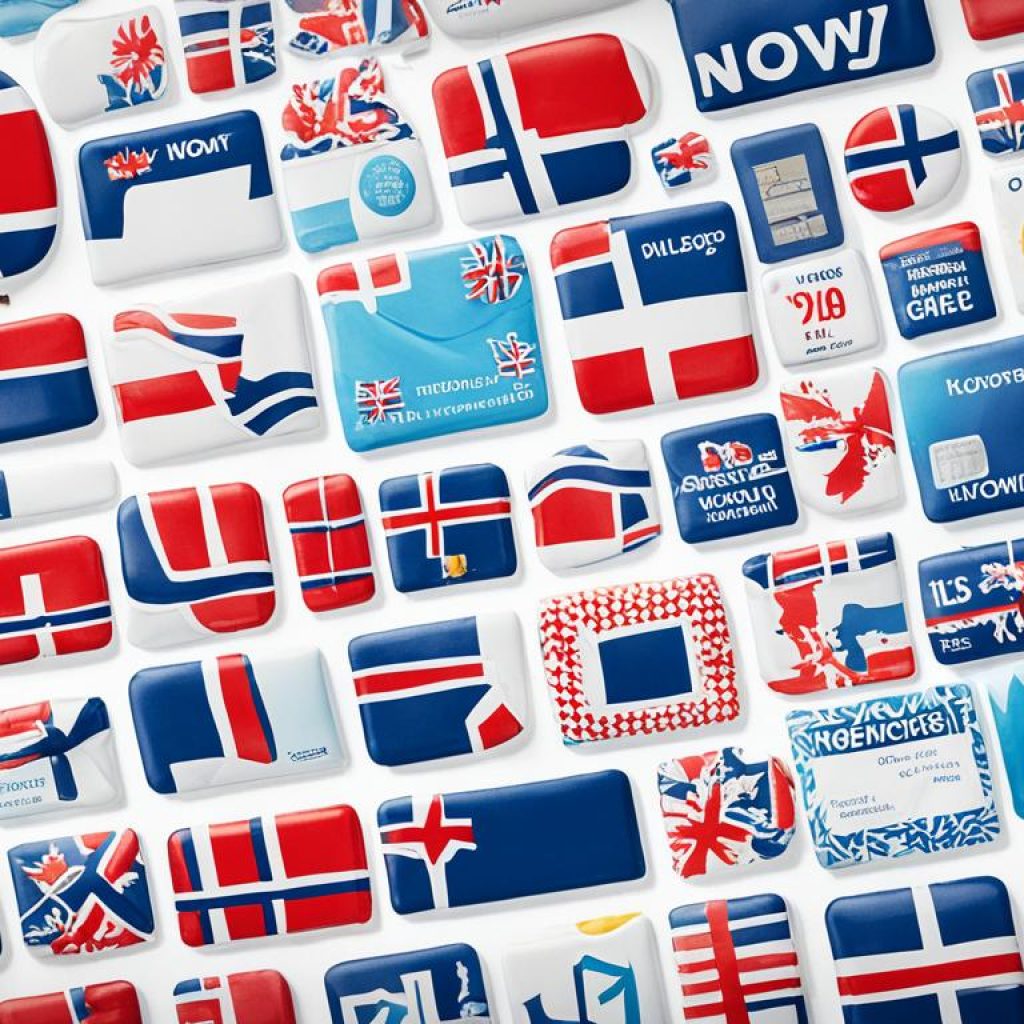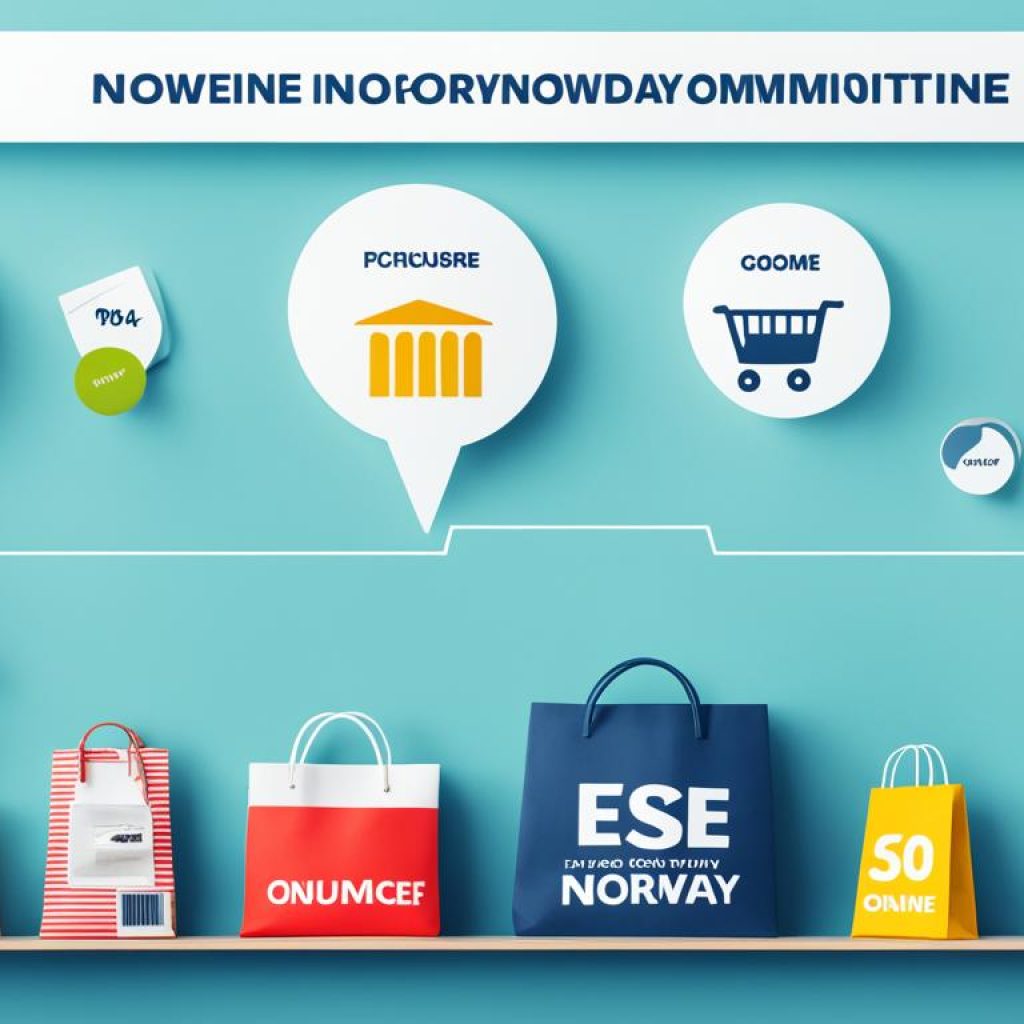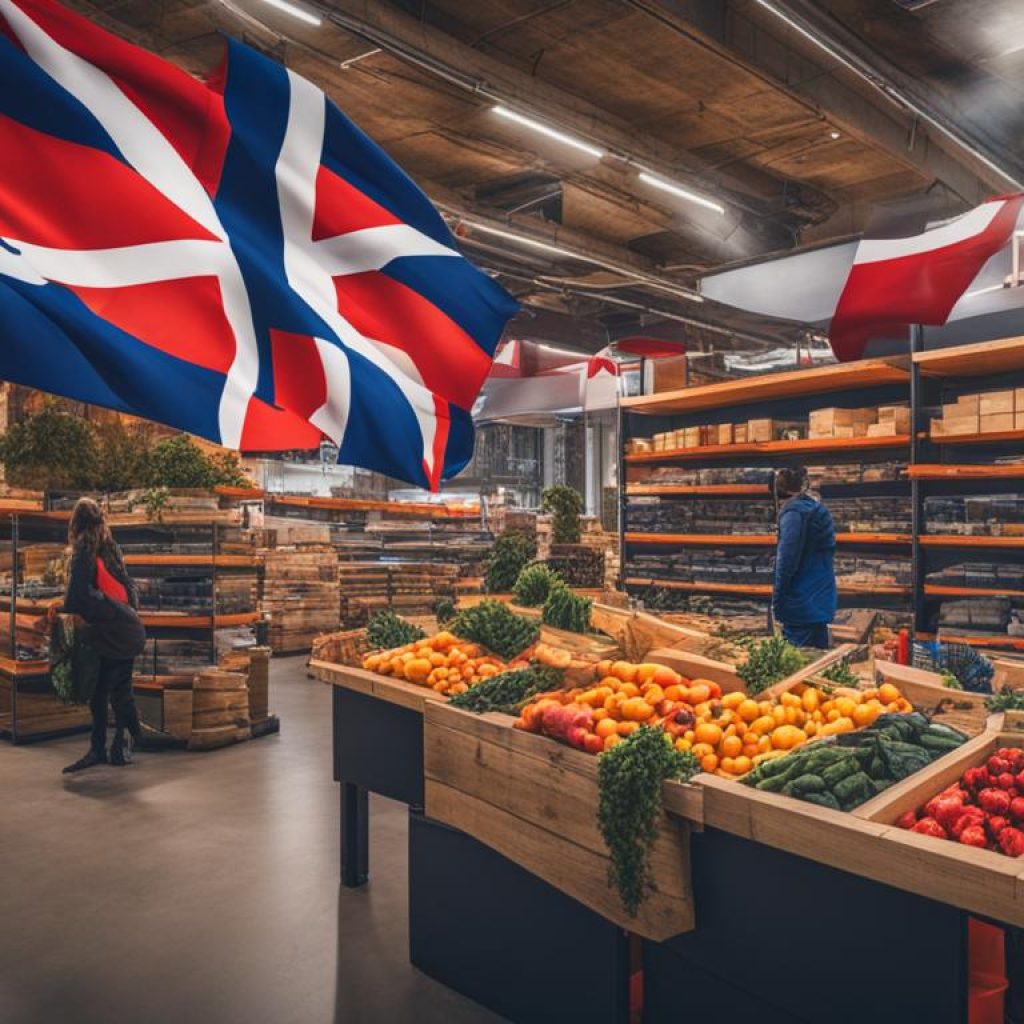The e-commerce market in Norway is experiencing significant growth, with a projected CAGR of 12.5% during the period 2022-2027. This growth is fueled by factors such as better quality transport infrastructure, rising urbanization, and high access to the Internet. Norway ranks well on the World Bank Logistics Performance Index, highlighting its efficient logistics and transport systems. Additionally, the country’s high internet penetration across both urban and rural areas supports the expansion of the e-commerce market.
Major players in the market are leveraging customer data and integrating artificial intelligence into their platforms to provide a personalized experience for consumers. This enables businesses to track consumers’ food purchases, gaining valuable insights into consumer behavior and market trends.
To understand the evolving market landscape, it is essential to analyze Norway’s tracking of food purchases. By monitoring consumer behavior and market trends, businesses can make informed decisions and adapt their strategies accordingly.
Key Takeaways:
- Norway’s e-commerce market is expected to grow at a CAGR of 12.5% during 2022-2027.
- The country’s efficient logistics and high internet penetration drive the growth of the e-commerce market.
- Tracking food purchases provides valuable insights into consumer behavior and market trends.
- Major players in the market leverage customer data and artificial intelligence for personalized experiences.
- Understanding consumer behavior and market trends is crucial for businesses to succeed in the e-commerce landscape in Norway.
Factors Driving Norway’s E-commerce Market Growth
The e-commerce market in Norway is experiencing significant growth, driven by various factors that contribute to its success. These factors include:
- Better Quality Transport Infrastructure: Norway’s ranking on the World Bank Logistics Performance Index reflects its efficient logistics and transport systems. This factor ensures the smooth movement of goods and timely deliveries, enhancing the overall e-commerce experience.
- Rising Urbanization: With the increasing urbanization in Norway, more consumers have access to e-commerce platforms, leading to a higher adoption rate. The convenience of online shopping coupled with the availability of a wide range of products has resulted in the growth of the e-commerce market.
- High Access to the Internet: Norway boasts high internet penetration across urban and rural areas, enabling widespread accessibility to online shopping platforms. This factor has played a crucial role in driving the growth of the e-commerce market, as consumers can easily browse products, compare prices, and make purchases from the comfort of their homes.
- Ease of Delivering Goods: Norway’s efficient logistics network allows for the seamless delivery of goods to customers. Expedited and reliable delivery services enhance customer satisfaction and encourage repeat purchases, thereby boosting the growth of the e-commerce market.
Furthermore, market players in Norway are leveraging customer data and capitalizing on the power of artificial intelligence (AI) to enhance the overall customer experience. By analyzing consumer behavior and preferences, businesses can personalize their offerings and provide tailored recommendations to customers.
To give you a visual overview, here’s a table showcasing the growth-driving factors in Norway’s e-commerce market:
| Factors Driving Growth in Norway’s E-commerce Market |
|---|
| Better Quality Transport Infrastructure |
| Rising Urbanization |
| High Access to the Internet |
| Ease of Delivering Goods |

Impact of COVID-19 on Norway’s E-commerce Market
The COVID-19 pandemic has had a profound impact on the e-commerce market in Norway. With physical restrictions and social distancing measures in place, customers have turned to online shopping as a convenient and safe alternative. As a result, the e-commerce industry in Norway has experienced significant growth.
One of the key factors driving this growth is the increased accessibility that e-commerce provides. Customers now have access to a wide variety of products from the comfort of their own homes. This has not only allowed them to fulfill their needs during the pandemic but has also opened up new opportunities for businesses to reach a larger customer base.
Many brick-and-mortar businesses that were heavily reliant on in-person sales have quickly adapted to the changing landscape by establishing or expanding their online presence. By embracing e-commerce, these businesses have been able to continue operating and maintain revenue streams during challenging times.
This shift towards e-commerce has further fueled the growth of the market in Norway. As more businesses and consumers realize the benefits and convenience of online shopping, the demand for e-commerce platforms and services continues to rise.
“The COVID-19 pandemic has acted as a catalyst for the expansion of e-commerce in Norway. It has not only transformed consumer behavior but has also forced businesses to rethink their strategies and adapt to the changing market dynamics.”
As we look ahead, it is clear that the impact of the pandemic on the e-commerce market in Norway will continue to shape the industry’s future. The growth and innovation witnessed during this challenging time have accelerated the digital transformation of businesses and highlighted the resilience and adaptability of the e-commerce ecosystem.
The COVID-19 pandemic has fundamentally reshaped consumer behavior and the way businesses operate. It has demonstrated the importance of having a strong online presence and the ability to connect with customers through digital channels. As the world slowly recovers from the pandemic, the e-commerce market in Norway is poised for continued growth and success.
Key Trends in Norway’s E-commerce Market
As the e-commerce market in Norway continues to expand, several key trends are shaping the industry and influencing consumer behavior. Understanding these trends is crucial for businesses seeking to thrive in the competitive market. Here are the key trends driving Norway’s e-commerce landscape:
1. Continued Growth of Online Shopping
Online shopping is experiencing significant growth in Norway, driven by the convenience it offers to consumers. With a high level of internet penetration and access to mobile devices, Norwegians are increasingly turning to online channels to make purchases. This trend is expected to continue as more consumers embrace the ease and flexibility of shopping from the comfort of their homes or on-the-go.
2. Use of Mobile Devices for E-commerce Transactions
Mobile devices, such as smartphones and tablets, have become the preferred method for conducting e-commerce transactions in Norway. With the availability of mobile-friendly websites and dedicated shopping apps, consumers can easily browse products, compare prices, and complete purchases using their mobile devices. E-commerce businesses must optimize their platforms for mobile to provide seamless and intuitive experiences for their customers.
3. Rise of Personalized Customer Experiences through Artificial Intelligence
The integration of artificial intelligence (AI) technologies is revolutionizing the e-commerce industry in Norway. Businesses are leveraging AI to analyze customer data, personalize recommendations, and enhance the overall shopping experience. AI-powered chatbots and virtual assistants are also being used to provide real-time customer support, improving customer satisfaction and retention.
4. Increasing Popularity of Cross-border E-commerce
Cross-border e-commerce is gaining traction in Norway, driven by the demand for unique products, competitive pricing, and access to international brands. Consumers are exploring online marketplaces and platforms that offer a wide range of products from around the world. E-commerce businesses are expanding their international partnerships and optimizing logistics to cater to this growing demand for cross-border shopping.
5. Focus on Expanding Reach and Launching New Products
Market players in Norway’s e-commerce industry are focused on expanding their reach and launching new products to gain a competitive edge. This includes partnering with local and international brands, expanding product categories, and exploring innovative marketing strategies. By constantly evolving and offering new and exciting products, businesses can attract and retain customers in the dynamic e-commerce landscape.
“The continued growth of online shopping, the use of mobile devices for e-commerce transactions, the rise of personalized customer experiences through AI, and the increasing popularity of cross-border e-commerce are key trends shaping Norway’s e-commerce market.” – Industry Expert
To visually understand the key trends in Norway’s e-commerce market, the table below provides an overview:
| Trend | Description |
|---|---|
| Continued Growth of Online Shopping | Increasing preference for online channels for purchases. |
| Use of Mobile Devices for E-commerce Transactions | Mobile devices becoming the primary tool for online shopping. |
| Rise of Personalized Customer Experiences through AI | Integration of AI technologies to enhance customer experiences. |
| Increasing Popularity of Cross-border E-commerce | Growing demand for international products and brands. |
| Focus on Expanding Reach and Launching New Products | Businesses expanding their market presence and product offerings. |
These trends highlight the evolving landscape of Norway’s e-commerce market, presenting both opportunities and challenges for businesses. By staying at the forefront of these trends, industry players can adapt their strategies to meet the changing needs of consumers and drive growth in the competitive market.

Market Size and Share of Norway’s E-commerce Market
The e-commerce market in Norway is poised for substantial growth in the coming years. According to industry forecasts, the market is projected to register a Compound Annual Growth Rate (CAGR) of 12.5% during the forecast period of 2024-2029. This is indicative of the increasing popularity and adoption of online shopping among Norwegian consumers.
As more consumers turn to the convenience of e-commerce, the market size and share of the e-commerce industry in Norway are expected to expand significantly. Currently, the market is fragmented, with several major players vying for a larger piece of the pie. These players recognize the immense potential of the market and are actively pursuing expansion, engaging in merger activities, and launching innovative products to gain a competitive edge.
To provide a visual representation of the market size and share, let’s take a look at the following table:
| Year | Market Size (Billion NOK) | Market Share (%) |
|---|---|---|
| 2024 | 30 | 15 |
| 2025 | 36 | 18 |
| 2026 | 43 | 22 |
| 2027 | 50 | 25 |
| 2028 | 57 | 29 |
| 2029 | 64 | 32 |
As seen in the table above, the market size is expected to grow steadily, reaching 64 billion NOK by 2029. This represents a significant opportunity for businesses operating in the e-commerce sector to capture a larger market share and establish themselves as key players in the industry.
The growth of the e-commerce market in Norway is driven by the increasing preference for online shopping, improved access to internet services, and the convenience offered by e-commerce platforms. As consumer behavior continues to evolve, businesses must adapt to meet their changing needs and expectations to thrive in the competitive landscape.
Image:

Challenges and Regulations in Norway’s E-commerce Market
In the dynamic landscape of Norway’s e-commerce market, various challenges and regulations shape the industry. These factors influence the fulfillment process, shipping, taxation, value-added tax (VAT), and compliance with EU regulations. To ensure the safety, legality, and protection of consumer rights, e-commerce platforms in Norway face several requirements and obligations.
Fulfillment Challenges
The process of fulfillment poses a significant challenge for e-commerce businesses in Norway. From warehouse management to inventory control and order processing, efficient fulfillment operations are crucial to meet customer expectations and maintain competitive advantage. E-commerce platforms need to invest in robust logistics systems and optimize their supply chain to ensure timely delivery and customer satisfaction.
Shipping Complexity
Shipping is a complex aspect of the e-commerce industry in Norway. The country’s geography, with its vast coastline and remote areas, presents unique challenges for last-mile delivery. Overcoming logistical hurdles and providing affordable and reliable shipping options across the country demands innovative solutions and strategic partnerships with logistics providers.
Taxation and VAT Compliance
Taxation and value-added tax (VAT) present significant challenges for e-commerce businesses operating in Norway. Compliance with tax regulations and ensuring accurate VAT calculations and reporting require robust financial systems and expertise in navigating the intricacies of Norwegian tax laws. E-commerce platforms must stay up-to-date with tax changes and implement appropriate measures to meet their tax obligations.
EU Regulations
Being a member of the European Union (EU), Norway is subject to EU regulations governing e-commerce. These regulations cover aspects such as data protection, privacy, consumer rights, and electronic transactions. E-commerce platforms operating in Norway must adhere to these regulations to maintain compliance and build trust with their customers.
“The successful navigation of the challenges and adherence to regulations will help e-commerce businesses thrive in Norway’s competitive market while delivering seamless experiences to consumers,” said Lisa Andersen, CEO of a leading e-commerce platform in Norway.
Annual Risk Assessments and Content Monitoring
In addition to the challenges mentioned above, e-commerce platforms in Norway are required to conduct annual risk assessments on available content. This process ensures that platforms report information associated with severe criminal offenses and suspend services that frequently provide illegal content. By proactively monitoring and addressing potential risks, e-commerce platforms can create a safer online environment for users.
| Challenges in Norway’s E-commerce Market | Regulations in Norway’s E-commerce Market |
|---|---|
| Fulfillment | Annual risk assessments |
| Shipping | Content monitoring |
| Taxation and VAT compliance | EU regulations |

Overcoming the challenges and complying with regulations in Norway’s e-commerce market requires strategic planning, investment in technology, and close collaboration with industry stakeholders. By recognizing and addressing these challenges, businesses can unlock growth opportunities and build a sustainable presence in Norway’s thriving e-commerce landscape.
Competitive Landscape of Norway’s E-commerce Market
The e-commerce market in Norway is highly competitive, with major players striving to gain market share and differentiate themselves through various strategies. This competitive landscape is characterized by expansion efforts, merger activities, and the introduction of new products and services.
Key Players in the Market
Some of the major players in Norway’s e-commerce market include:
- Prisjakt Sverige AB
- Elkjøp
- FINN.no
- Komplett AS
- Power.no
These companies have established themselves as prominent players in the market and have garnered a significant customer base. They continually strive to offer unique products, exceptional customer service, and innovative solutions to maintain their competitive edge.
Expansion and Merger Activities
One of the strategies employed by these major players is expansion. They focus on expanding their reach by entering new markets or launching additional branches and stores across the country. This helps them tap into new customer segments and strengthen their market presence.
In addition, merger activities are prevalent within the e-commerce market in Norway. Companies may merge to consolidate their resources, leverage their strengths, and enhance their competitive position. By joining forces, they can optimize their operations and offer a wider range of products and services to their customers.
Launch of New Products
A key aspect of the competitive landscape is the continuous launch of new products and services by major players in Norway’s e-commerce market. These companies understand the importance of meeting evolving customer needs and preferences. By introducing innovative and unique offerings, they aim to attract new customers and retain existing ones.

Market Segmentation of Norway’s E-commerce Market
The Norway e-commerce market can be classified into two main segments: B2C and B2B e-commerce. Each segment caters to distinct consumer needs and serves different industries.
B2C E-commerce:
B2C e-commerce encompasses a wide range of applications, including:
- Beauty and personal care
- Consumer electronics
- Fashion and apparel
- Food and beverages
- Furniture and home
- And others
These categories cover various consumer goods and have witnessed significant growth in online sales. With the convenience of online shopping, consumers can easily browse and purchase products from the comfort of their own homes. The market size for B2C e-commerce is expected to continue expanding over the forecast period, driven by evolving consumer preferences and increasing internet penetration.
B2B E-commerce:
In addition to B2C e-commerce, the B2B segment is a significant part of Norway’s e-commerce market. B2B e-commerce specifically caters to the purchasing needs of businesses, offering a digital platform for sourcing products and services. This segment enables businesses to streamline their procurement processes, access a wider range of suppliers, and benefit from competitive pricing.
The B2B e-commerce segment serves various industries, including manufacturing, wholesale, and professional services. It empowers businesses to source raw materials, equipment, and other goods necessary for their operations in a seamless and efficient manner.
Both B2C and B2B e-commerce contribute to the overall growth and development of Norway’s e-commerce market. By understanding the unique characteristics and demands of each segment, businesses can tailor their strategies to capture opportunities and meet the diverse needs of consumers and businesses alike.
Future Outlook of Norway’s E-commerce Market
The future of Norway’s e-commerce market looks promising, with several factors paving the way for continued growth and innovation. Anticipated advancements in technology, coupled with the increasing adoption of online shopping by consumers, are expected to drive the expansion of the market.
Market players are keenly aware of the changing consumer preferences and demands, thus placing a strong emphasis on providing personalized customer experiences. By leveraging customer data and employing artificial intelligence, businesses aim to create tailored shopping journeys that cater to individual needs and interests.
Furthermore, the e-commerce market in Norway is poised for an expansion in terms of market size. As more consumers shift towards online shopping, businesses are actively working towards expanding their reach to gain a competitive edge. This includes exploring new market segments, entering strategic partnerships, and expanding their product offerings to cater to a wider audience.
Technological advancements and digital innovations will continue to shape the future of Norway’s e-commerce market. From augmented reality to voice commerce, businesses are constantly exploring and adopting cutting-edge technologies to enhance the overall online shopping experience. These advancements not only streamline the purchasing process but also create new opportunities for engagement and interaction.
The Rise of Sustainable E-commerce
One noteworthy trend in the future of Norway’s e-commerce market is the increasing focus on sustainability. Consumers are becoming more conscious of their environmental impact and are actively seeking out brands that align with their values. As a result, e-commerce businesses in Norway are incorporating sustainable practices into their operations, offering eco-friendly products, and optimizing their supply chains to reduce carbon emissions.
“Sustainability is no longer a mere buzzword; it has become a crucial consideration for businesses looking to thrive in the evolving e-commerce landscape. By embracing sustainability, businesses can attract environmentally conscious consumers, enhance their brand value, and contribute to a greener future,” says Kareem Johnson, CEO of GreenCo, a leading sustainable e-commerce platform.
The future outlook for Norway’s e-commerce market is promising, driven by technological advancements, personalized customer experiences, and a growing focus on sustainability. As the market continues to evolve, businesses must stay agile and adaptable to seize the opportunities presented by these trends and create a thriving e-commerce ecosystem in Norway.
Conclusion
Norway’s tracking of food purchases provides valuable insights into consumer behavior and market trends. The e-commerce market in Norway is experiencing steady growth, fueled by factors such as better transport infrastructure, urbanization, and high internet penetration.
The COVID-19 pandemic has further accelerated the growth of e-commerce in Norway, as businesses have adapted to the changing landscape and turned to online channels to continue operating. This unprecedented shift in consumer behavior has presented new opportunities for industry players.
As the market continues to evolve, it is crucial for businesses to stay informed about the latest trends and leverage data and technology to navigate the dynamic e-commerce landscape successfully. Understanding consumer behavior and adapting strategies accordingly will be key to capturing market share and driving growth in Norway’s e-commerce sector.
FAQ
What are the factors driving the growth of Norway’s e-commerce market?
The factors driving the growth of the e-commerce market in Norway include better quality transport infrastructure, rising urbanization, high access to the Internet, and the ease of delivering goods.
How has the COVID-19 pandemic impacted Norway’s e-commerce market?
The COVID-19 pandemic has accelerated the expansion of e-commerce in Norway, as it has provided customers with access to a variety of products and enabled businesses to continue operating despite physical restrictions.
What are the key trends in Norway’s e-commerce market?
Key trends in Norway’s e-commerce market include the continued growth of online shopping, the use of mobile devices for e-commerce transactions, the rise of personalized customer experiences through the integration of artificial intelligence, and the increasing popularity of cross-border e-commerce.
What is the market size and share of Norway’s e-commerce market?
The market size and share of the e-commerce market in Norway are expected to continue growing as more consumers turn to online shopping.
What are the challenges and regulations in Norway’s e-commerce market?
Challenges in Norway’s e-commerce market include fulfillment, shipping, taxes, value-added tax (VAT), and EU regulations. E-commerce platforms are required to conduct annual risk assessments on the available content and report information associated with severe criminal offenses. They are also required to suspend services that frequently provide illegal content.
How does the competitive landscape of Norway’s e-commerce market look?
The competitive landscape of Norway’s e-commerce market is fragmented, with major players focusing on expansion, merger activities, and the launch of new products.
What is the market segmentation of Norway’s e-commerce market?
The Norway e-commerce market can be segmented into B2C and B2B e-commerce, catering to businesses’ needs for online purchasing.
What is the future outlook of Norway’s e-commerce market?
The future outlook of Norway’s e-commerce market is positive, with projected growth in market size, increased adoption of online shopping by consumers, and advancements in technology driving innovation in the industry.
